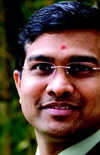Ayurveda has been practiced in the U.S. for only about 30 years, yet it is a 5,000 year old Indian system of medicine and yoga’s sister science. Readers are invited to submit questions for “Ayurveda Q & A” to ayurveda@layogamagazine.com.
Q: My interconnected issues involve extensive skin problems and inability to maintain a healthy weight. While doctors assume I have anorexia, I enjoy eating and want to gain weight. I’ve been diagnosed with leaky gut syndrome and eczema. Dermatologists feel I need to use cortisone creams the rest of my life, but my body’s reaction to them is more unbearable than the eczema.
I have been to an Ayurvedic Clinic in Kerala for two months for specific treatments and panchakarma (Ayurvedic cleansing techniques). This was excellent; I returned to Europe weak, but with clear skin and gradually gained weight. The Ayurvedic doctors told me to eat only white rice with 1 tablespoon of home-made ghee 2-3 times per day, cooked vegetables, steamed apples and occasional legumes (especially sprouted mung), no spices, sugar and little salt. This worked initially, but now my body does absorb nutrition and I have had a bad reaction to the ghee. Also, in Europe, I cannot get Indian vegetables and need recommendations for European vegetables.
Now my skin is worse, and I cannot bear standing as my feet swell immediately and the pressure causes cracking and oozing. I barely sleep at night due to itching and pain. Can you suggest foods to promote weight gain, and suggestions for my skin and sleep?
A: From the details you provided, your constitution seems to be vata (air/ether or space) type and has a tendency to be thrown out of balance quite easily. In addition, the pathological states that you are going through also reflect vitiation of vata. As the constitution and the imbalance are an outcome of the same dosha of vata, the symptoms are more severe and it can be challenging to establish balance. Careful supervision and guidance are very much needed for bringing back health, and also to maintain it.
Ayurveda
Balancing the body through panchakarma, herbs and other methods (known in Sanskrit as yukti vyapashraya chikitsa).
Reassuring the mind through counseling, pranayama (breathing techniques), meditation and related practices (known in Sanskrit as satvavajaya chikitsa).
Look for a qualified Ayurvedic practitioner near you who can support you.
If it has been more than three months since the last panchakarma, it is recommended to repeat another course, for a shorter duration. While panchakarma is being carried out by the practitioner following a prescribed diet may be beneficial.
Ayurvedic Diet
Breakfast
- Warm cereal (oats, rice, bulgur), cooked with raisins, figs, dates, apples or pears. Add goat milk or unsweetened almond milk.
- Twice a week spelt bread with nut butters (almond, cashew) is another option.
Lunch
Cooked grains (quinoa, rice, spelt) along with steamed veggies like asparagus, zucchini (known in Europe as courgettes), okra, fennel bulbs, carrots, green beans, butter squash, beets, radish or daikon radish.
Add a little quantity of chicken, turkey or freshwater fish to contribute to weight gain. Goat cheese can be consumed three to four times a week.
Dinner
Favor well-cooked soups with broth, mixtures of local (in your area) vegetables and grains (quinoa, rice, spelt or bulgur).
Avoid:
- Vata-aggravating food such as crackers, chips, chewing gum and hard, dry, rough or cold articles in general.
- Caffeine, spicy food, soda and refined sugar are also vata-aggravating.
- Irregular food habits can greatly contribute to worsen the condition.
Favor:
- Regular meal times or eating habits.
- Whole grains.
- Healthy oils including coconut, olive oil and ghee.
- Meat soup, but not meat alone.
- Spices: ajwain, cumin, ginger, cardamom, garlic.
Herbs:
Vidari kanda (Puraria tuberose), guggulu (Commifora mukul) and shilajit.
Bala (Sida cardifolia) is strengthening, but not approved by the FDA for external use. Bala (the word in Sanskrit literally means strength) can be used externally in massage oil to soothe vata and strengthen the body. Banyan Botanicals (banyanbotanicals.com) makes bala ashwagandha oil and bala is an ingredient in their vata massage oil. All of their oils are certified organic.
It seems to me that your mind is using the largest sense organ, the skin, to express its disturbance; herbs like anatmul (Hemidesmus indicus), manjishta (Rubia cordifolia) and punarnava (Boerhavia diffusa) can be helpful.
Sleep
Sleep at regular hours so that the vata gets into the rhythm naturally.
Pranayama practice like samavritti (Equal breath: without strain, practice the same count inhaling, holding after the inhalation, exhaling, holding after the exhalation. Four counts for each part is an option.) and a soft ujjayi (the ocean or Darth Vadar breath create by ever-so-slightly constricting the back of the throat) along with twenty-minute meditation practice twice every day may prove beneficial for sleep. Learn pranayama with an experienced teacher and only practice breath retention if appropriate to your unique situation.
To help calm the mind: in the evening drink half a cup of juice of winter melon/wax gourd, called dong gua (Benincasa hispida) in Chinese Medicine with 1 teaspoon of brahmi. Alternately, tea can be made.
Before using any of the above Ayurvedic remedies, consult with a qualified Ayurvedic practitioner or healthcare provider. The information given here represents the opinions and recommendations of the author and does not necessarily reflect the views of LA YOGA Ayurveda and Health magazine.
Dr. Parla Jayagopal has an M.D. degree in Ayurveda from India and works as an Associate Professor at American University of Complementary Medicine; he teaches clinical doctorate courses and schedules consultations at the university clinic in Beverly Hills. (310)550–7445; www.aucm.org
By Dr. Parla Jayagopal

